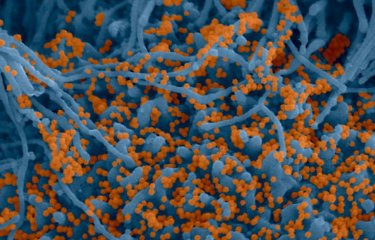-
Document de presse | 2006.03.22
Advances in research into a new tuberculosis vaccine
Researchers at the Pasteur Institute and the University of Zaragoza have developed a novel strategy to produce a new tuberculosis vaccine candidate. In an article published in Vaccine, they demonstrate that inactivation of a single gene in the tuberculosis bacillus gives rise to a strain that is more attenuated than BCG and which provides better protection against the disease. This work paves the...
-
Document de presse | 2006.02.05
HHS and Institut Pasteur Partner On Pandemic Influenza Preparedness
Paris, France—The U.S. Department of Health and Human Services (HHS) and Institut Pasteur (IP) today agreed to carry out joint activities, beginning in Southeast Asia, to strengthen global capacity to detect influenza viruses that could have the potential to trigger a human pandemic. Press release Paris, febuary 6, 2006 The Memorandum of Understanding (MOU),...
-
Document de presse | 2006.01.09
Identification of a new human genetic factor involved in susceptibility to tuberculosis
Teams from the Institut Pasteur and the CNRS have just identified a new human genetic factor involved in susceptibility to tuberculosis. Researchers analysed the extent to which variability of the DC-SIGN gene could be involved in susceptibility to become sick after Mycobacterium tuberculosis infections, in a large South African population. They showed that a variant of this gene is over-...
-
Document de presse | 2005.12.10
The mechanisms that trigger a debilitating genetic disease have been unveiled
Researchers from the Institut Pasteur and the CNRS have unravelled the cellular mechanisms that are deregulated in polycystic kidney disease (PKD), a life threatening genetic disease that damages kidney function. The authors showed that the dilation of renal tubules leading to cyst formation is linked to a disorganised growth of tubular cells. This research, published in “Nature Genetics...
-
Document de presse | 2005.11.27
Glaxosmithkline Biologicals Licenses Institut Pasteur Technology to develop AIDS Vaccine; Innovative Public-Private Partenership will use Measles Vaccine As starting point
Using an ancient scourge to combat a new one, researchers from GlaxoSmithKline Biologicals and the Institut Pasteur announced a new European collaboration to develop an AIDS vaccine by fusing genes from the human immunodeficiency virus (HIV) onto an existing measles vaccine. Press release Paris, november 28, 2005 GSK Biologicals will license the measles vaccine vector...
-
Document de presse | 2005.11.07
Malaria: an innovative approach for developing a vaccine
Researchers at the Institut Pasteur have developed a novel approach in order to design a vaccine candidate against malaria based on clinical observations in humans. Among populations infected by malaria, they sought to discover which antigens trigger immune responses capable of eliminating the Plasmodium falciparum parasite. In a phase I clinical trial, they showed that protective antibodies...
-
Document de presse | 2005.10.12
Institut Pasteur and Total join forces to combat infectious diseases
On October 13, Total and Institut Pasteur signed a corporate funding agreement intended to strengthen the scientific and human resources allocated to the fight against infectious diseases, especially sexually transmitted diseases (STD). The five-year agreement covers two areas. Press release Paris, october 13, 2005 · Support for Institut Pasteur’s research...
-
Document de presse | 2005.09.28
The keys to life in the extreme cold
A team from the Institut Pasteur and the CNRS, in collaboration with the Genoscope, has deciphered the clever mechanisms developed by a bacterium allowing it to flourish in the heart of Antarctica. In scrutinizing its genome, the researchers revealed several developments in this bacterium's metabolism that allow it both to resist very low temperatures and to flourish there quite effectively....
-
Document de presse | 2005.09.05
Cholera: How Parasites Make Bacteria Pathogenic
Vibrio cholerae, the bacteria that causes cholera, is made pathogenic by one of its parasites, the CTX virus. This virus enables the vibrio to produce a toxin that causes the lethal diarrhea of cholera. Researchers at the CNRS and Institut Pasteur have recently proven, in a work published in Molecular Cell, which adaptive method the CTX bacteriophage uses to propagate itself so effectively in the...
-
Document de presse | 2005.09.01
Mrs Alice Dautry appointed Managing Director of Institut Pasteur
The Board of Directors of the Institut Pasteur met on 2 September 2005 with a view to appointing the new Managing Director. Press releaseParis, september 2, 2005 During its previous meetings the Board of Directors :- had decided to create a Search Committee in order to receive, attract and then scientifically analyse applications, before drawing up a shortlist of applicants...


